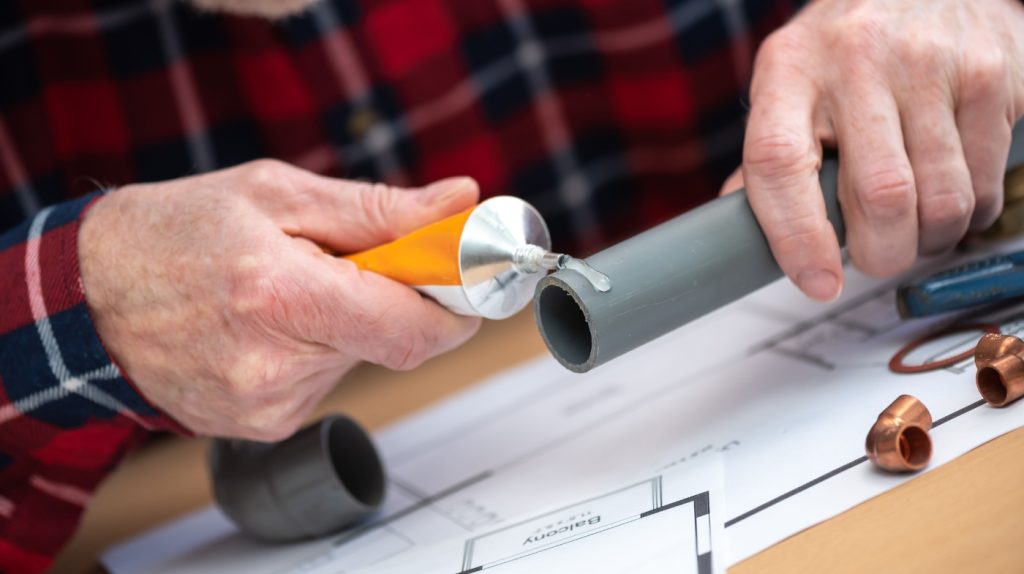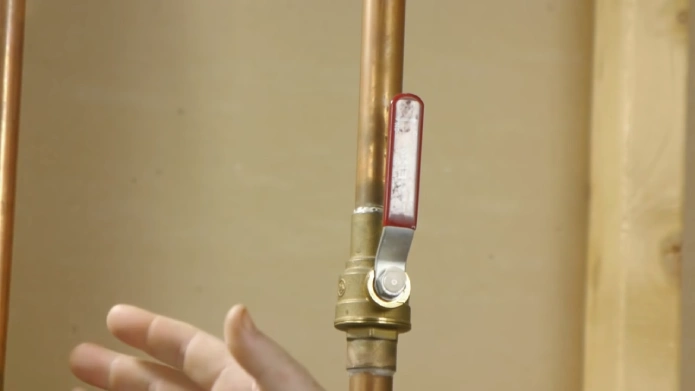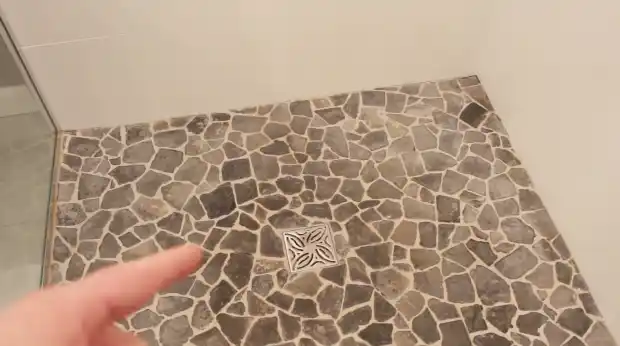Last Updated on August 3, 2025
You can’t use PVC glue on CPVC because their chemical differences prevent a proper bond. CPVC’s higher chlorine content creates a tougher surface that PVC adhesive can’t soften or penetrate effectively. This leads to weak joints prone to leaks and failure under pressure or heat.
For reliable connections, you need solvent cement formulated specifically for CPVC, meeting ASTM F493 standards. Understanding these material distinctions guarantees lasting, code-compliant plumbing installations, and further details clarify best practices.
Key Takeaways
- PVC glue lacks the chemical aggressiveness to properly soften and bond CPVC pipe surfaces.
- Using PVC glue on CPVC results in weak joints prone to leaks and failure under stress.
- CPVC requires solvent cement meeting ASTM F493 standards for reliable, code-compliant bonding.
- Proper CPVC cement contains specific solvents designed to chemically fuse CPVC pipe materials.
- For secure CPVC joints, always use adhesives specifically formulated for CPVC, not PVC glue.
Chemical Differences Between PVC and CPVC
Although PVC and CPVC share a similar vinyl chloride backbone, their chemical differences stem primarily from CPVC’s higher chlorine content, which results from a free radical chlorination process that replaces some hydrogen atoms with chlorine.
PVC contains about 25% chlorine atoms by bonding sites, whereas CPVC’s chlorine content rises to roughly 40%, increasing its mass percent chlorine from 56.7% in PVC to between 63% and 69%.
This difference in composition also influences the types of adhesives and solvents that are compatible with each material. This chlorine enrichment causes CPVC’s molecular structure to have larger chlorine atoms that shield the carbon backbone more effectively.
As a result, CPVC exhibits enhanced chemical resistance and thermal stability compared to PVC. The increased chlorine also restricts molecular motion, contributing to improved dimensional stability and rigidity, making CPVC more suitable for demanding chemical and temperature environments.
Additionally, CPVC can maintain higher pressure ratings at elevated temperatures, such as at 130°F, where it sustains about 131.1 psi compared to PVC’s 71.3 psi, highlighting its superior temperature and pressure resistance.
Why PVC Glue Is Ineffective on CPVC?
The increased chlorine content in CPVC not only enhances its chemical resistance and thermal stability but also demands a different approach to bonding compared to PVC. PVC glue lacks the aggressiveness needed to properly soften CPVC’s tougher surface, resulting in weak joints and potential leaks.
Since CPVC requires a stronger solvent action, PVC glue fails to chemically fuse its pipes effectively. This mismatch compromises joint integrity, especially under thermal and pressure stresses common in CPVC applications.
Proper preparation, such as ensuring a clean workspace, is essential to achieve optimal bonding conditions.
- PVC glue can’t penetrate CPVC’s higher melting point surface.
- Inadequate chemical interaction leads to poor surface fusion.
- Weaker bonds increase risk of leaks and failures.
- PVC glue is optimized for PVC’s physical properties, not CPVC’s.
- Incorrect glue use violates plumbing codes and voids warranties.
Because CPVC can withstand temperatures up to 200°F, it requires adhesives formulated specifically for its material properties.
Proper Solvent Cement Selection for CPVC
When selecting solvent cement for CPVC piping, you must adhere to ASTM F493 standards, which define the required chemical composition, performance characteristics, and testing methods.
The solvent cement should be a CPVC resin-based solution, free of lumps or foreign matter, with appropriate viscosity for your pipe size and application—medium-bodied cements suit typical residential pipes, while heavy-bodied formulas fit larger industrial systems.
Understanding the differences between pressure regulators and pressure reducing valves can help in choosing compatible system components, particularly since PRVs are typically designed for specific liquid applications and can affect system pressure working components.
ASTM F493 covers resin content, dissolution ability, viscosity, shelf life, and hydrostatic pressure performance, ensuring joint integrity under operational stresses.
This standard is also incorporated into the 2012 International Mechanical, Plumbing, and Residential Codes, ensuring regulatory compliance across installations.
Rely on manufacturer guidelines alongside ASTM standards, and consider color coding and shelf life to guarantee a reliable, code-compliant bond for your CPVC system.
Proper selection is crucial because pressure regulators maintain high levels of accuracy, while pressure-reducing valves are less precise.
Guidelines for Joining PVC and CPVC Pipes
Since PVC and CPVC pipes differ slightly in internal diameters despite similar outer dimensions, you must carefully verify nominal pipe sizes to guarantee a proper fit. Use fittings and pipes with compatible sizing standards, like CPVC NPS, to avoid leaks.
Prepare all surfaces by cleaning and priming with the correct primer for each material to promote solvent penetration. Apply solvent cement liberally and evenly on both joint surfaces, then assemble immediately, holding parts securely during initial set.
Recognize that solvent cementing is not a glue, but rather a process that chemically fuses pipe and fitting at a molecular level. Proper installation ensures the joint can withstand system pressure without failure.
Consider environmental factors such as temperature and humidity to ensure proper curing and use mechanical supports to minimize joint stress.
- Confirm nominal pipe size compatibility
- Clean and prime all bonding surfaces thoroughly
- Use appropriate solvent cement for CPVC-PVC joints
- Assemble joints promptly and hold firmly
- Install within recommended temperature and humidity ranges
Risks and Limitations of Using PVC Glue on CPVC
Although PVC glue may seem like a convenient choice, it doesn’t provide the chemical bond necessary for CPVC pipes. The different chemical composition means PVC cement can’t properly soften or fuse CPVC surfaces, risking weak joints prone to leaks and failures.
CPVC cement contains specific solvents like tetrahydrofuran and acetone that are formulated to penetrate crevices and create durable bonds with CPVC materials, which PVC glue lacks.
Using the wrong adhesive compromises pressure resistance, thermal stability, and durability, potentially voiding warranties and increasing maintenance costs. Understanding the differences in pipe materials is crucial to selecting the appropriate adhesive for plumbing applications.
| Risk Category | Impact | Consequence |
|---|---|---|
| Chemical Bond | Weak, incomplete fusion | Leak formation, joint failure |
| Mechanical Stress | Reduced pressure resistance | Seal failure under pressure |
| Thermal Stability | Poor heat resistance | Cracks, brittleness |
| Durability | Accelerated degradation | Premature replacement required |
Frequently Asked Questions
How Can I Identify CPVC Pipe Versus PVC Pipe Visually?
You can identify CPVC pipes by their off-white, light gray, or yellow shades, often with a distinctive gold stripe, unlike the white or dark gray of PVC pipes. Check printed specifications on the pipe surface for material type and standards.
Notice CPVC’s plain ends versus PVC’s bell ends, and consider flexibility and thickness differences. These visual cues help you quickly distinguish CPVC from PVC on-site.
Are There Any Brands That Offer Dual-Purpose Solvent Cement?
You want reliability, versatility, and compliance. Brands like Oatey, Weld-On, RectorSeal, Christy’s, and IPS Weld-On offer dual-purpose solvent cements designed for both PVC and CPVC pipes.
These products balance solvent and resin mixtures, meet ASTM standards, and often require primers for strong bonding. Always check technical specs and certifications to verify suitability for your application.
What Tools Are Recommended for Prepping CPVC Pipe Surfaces?
You should use chemical primers like Weld-On® PC-64™ to prep CPVC pipe surfaces, applying them with daubers, swabs, or appropriately sized paintbrushes for controlled coverage. Avoid rags to prevent contamination.
Clean the pipe thoroughly before priming. For cutting, use ratchet or wheel-type cutters designed for plastic, and ream or deburr edges with tools sized to the pipe diameter. Proper surface prep guarantees strong, reliable solvent cement bonds.
How Long Does CPVC Solvent Cement Take to Cure Fully?
CPVC solvent cement takes time to cure fully, like paint drying on a wall. Typically, small pipes (½” to 1¼”) cure in about 2 hours at 60°F or higher. Larger pipes need longer—up to several days for diameters above 4″.
Temperature, humidity, pipe size, and pressure affect cure time. Always follow manufacturer guidelines and add 50% extra time in humid or cold conditions to guarantee a strong, leak-proof joint.
Avoid Plumbing Pitfalls: Use the Right Solvent Cement
You might think PVC glue works on CPVC since they look similar, but their chemical differences mean it won’t bond properly. Using the wrong solvent cement risks leaks and weak joints, which can cause costly damage.
To guarantee a secure, durable connection, always choose the correct CPVC cement designed for its unique properties. Don’t let a small mix-up compromise your project’s integrity select the right adhesive every time for reliable results.



